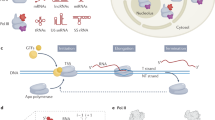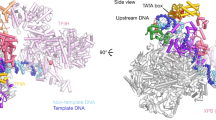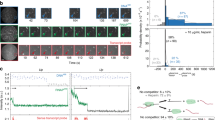Abstract
The time of onset of transcriptional activity in the early mammalian embryo is unclear. RNA synthesis has been shown to occur at the two-cell stage in the mouse1–4 and at the two- to four-cell stage in the rabbit5, but the period immediately following fertilization has proved largely inaccessible to biochemical characterization of transcription because of the low permeability of early embryos to exogenous precursors such as 3H-uridine1–7. This difficulty, and the failure to detect RNA polymerase activity in the pronuclei of one-cell mouse embryos8, suggested that the embryonic genome was transcriptionally inactive until some time after the first cleavage. To investigate this issue further, we have now incubated one-cell pronuclear embryos with 3H-adenosine, which is taken up about 1,000 times faster than uridine3. Three labelled RNA species could be identified. The major product is large, heterodisperse, poly(A)− RNA. High-molecular-weight poly(A)+ RNA is also heavily labelled but this is mostly due to cytoplasmic polyadenylation of previously non-polyadenylated, stored RNA. A significant amount of label is incorporated into the -CCA termini of transfer RNA but some new synthesis of tRNA also takes place. No label was found in ribosomal RNA at the one-cell stage but synthesis of mature rRNA species was evident in the two-cell embryo.
This is a preview of subscription content, access via your institution
Access options
Subscribe to this journal
Receive 51 print issues and online access
$199.00 per year
only $3.90 per issue
Buy this article
- Purchase on Springer Link
- Instant access to full article PDF
Prices may be subject to local taxes which are calculated during checkout
Similar content being viewed by others
References
Woodland, H. R. & Graham, C. F. Nature 221, 327–332 (1969).
Knowland, J. & Graham, C. J. Embryol. exp. Morph. 27, 167–176 (1972).
Clegg, K. B. & Pikó, L. Devl Biol. 58, 76–95 (1977).
Levey, I. L., Stull, G. B. & Brinster, R. L. Devl Biol. 64, 140–148 (1978).
Cotton, R. W., Manes, C. & Hamkalo, B. A. Chromosoma 79, 169–178 (1980).
Daentl, D. L. & Epstein, C. J. Devl Biol. 24, 428–442 (1971).
Young, R. J., Sweeney, K. & Bedford, J. M. J. Embryol. exp. Morph. 44, 133–148 (1978).
Moore, G. P. M. J. Embryol. exp. Morph. 34, 291–298 (1975).
Barlow, J. J., Mathias, A. P., Williamson, R. & Gammack, D. B. Biochem. biophys. Res. Commun. 13, 61–66 (1963).
Bellamy, A. R. & Ralph, R. K. Meth. Enzym. 12A, 156–160 (1968).
Pikó, L. & Chase, D. G. J. Cell Biol. 58, 357–378 (1973).
Randerath, E., Chia, L. S. Y., Morris, A. P. & Randerath, K. Cancer Res. 34, 643–653 (1974).
Deutscher, M. P. Prog. Nucleic Acid Res. molec. Biol. 13, 51–92 (1973).
Vournakis, J. N., Gelinas, R. E. & Kafatos, F. C. Cell 3, 265–273 (1974).
Pikó, L. & Clegg, K. B. Devl Biol. 89, 362–378 (1982).
Slater, I., Gillespie, D. & Slater, D. W. Proc. natn. Acad. Sci. U.S.A. 70, 406–411 (1973).
Wilt, F. H. Proc. natn. Acad. Sci. U.S.A. 70, 2345–2349 (1973).
Wilt, F. H. Cell 11, 673–681 (1977).
Dolecki, G. J., Duncan, R. F. & Humphreys, T. Cell 11, 339–344 (1977).
Davis, F. C. & Davis, R. W. Devl Biol. 66, 86–96 (1978).
Young, R. J. & Sweeney, K. J. Embryol. exp. Morph. 49, 139–152 (19791).
Engel, W., Zenzes, M. T. & Schmid, M. Hum. Genet. 38, 57–63 (1977).
Hansmann, I., Gebauer, J., Bihl, L. & Grimm, T. Expl Cell Res. 114, 263–268 (1978).
Bachvarova, R. & De Leon, V. Devl Biol. 74, 1–8 (1980).
Braude, P., Pelham, H., Flach, G. & Lobatto, R. Nature 282, 102–105 (1979).
Loening, U. E. Biochem. J. 113, 131–138 (1969).
Randerath, K. & Randerath, E. Meth. Enzym. 12A, 323–347 (1967).
Author information
Authors and Affiliations
Rights and permissions
About this article
Cite this article
Clegg, K., Pikó, L. RNA synthesis and cytoplasmic polyadenylation in the one-cell mouse embryo. Nature 295, 342–345 (1982). https://doi.org/10.1038/295342a0
Received:
Accepted:
Issue Date:
DOI: https://doi.org/10.1038/295342a0
This article is cited by
-
Non-random fertilization in mice correlates with the MHC and something else
Heredity (1996)
-
Early transcription in different animal species: implication for transition from maternal to zygotic control in development
Roux's archives of developmental biology (1994)
-
Stage-specific gene expression in asynchronous tetraploid mouse embryos formed by fusion of blastomeres and fertilized eggs
Roux's Archives of Developmental Biology (1993)
Comments
By submitting a comment you agree to abide by our Terms and Community Guidelines. If you find something abusive or that does not comply with our terms or guidelines please flag it as inappropriate.



